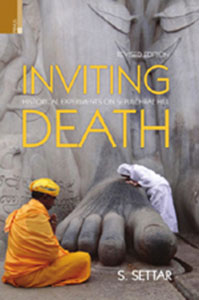
Inviting Death: Historical Experiments on Sepulchral Hill (Revised Edition)
AUTHOR – S. Settar
| HB ₹1395 . $ 84.95 . ₤ 56.95 |
e-Book ₹ 1245 . $ 76.95 . ₤ 49.95 |
|
INFORMATION
- AUTHOR : S. Settar
- HB ISBN : 978-93-80607-42-9
- EBOOK ISBN : 978-93-84090-54-2
- Year : 2016
- Extent : 298 pp.
- Discount available on checkout
- Usually dispatched within 3 to 5 working days.
Inviting Death
| HB ₹ 1395 . $ . ₤ |
PB ₹ . $ . ₤ |
|
| POD ₹ . $ . ₤ |
e-Book ₹ . $ . ₤ |
INFORMATION
- AUTHOR – S. Settar
- ISBN – 978-93-80607-42-9
- Year – 2016
- Extent: 400 + 40 coloured illustrations
- 10% discount + free shipping
- Usually dispatched within 3 to 5 working days.
One of the foremost communities to have paid serious attention to death are the Jainas of India. Indeed, their preoccupation with it has been so intense that without understanding their philosophy of death, it is almost impossible to make out their notion of life. While commending death, however, they caution against throwing away life in a cavalier manner. They emphatically oppose suicide-a death-recourse prompted by emotion (raga) and violence (himsa)-and condemn it as a spiritual crime, a cowardly act resorted to by the immature and the ignorant. Jainism recognizes fortyeight types of deaths, grouped under three major heads called bala-marana (foolish death), pandita-marana (wise death), and pandita-pandita-marana (the wisest of wise deaths). For them, sallekhana is an art of mortification, which is completed without hurting the soul or harming the mind. The Jainas did not consider death a subject of intellectual exercise; they held it as a force that permeates the social, religious and philosophical sinews of life.
Inviting Death presents this history spread over a millennium and half, on the Samadhibetta or the Sepulchral Hill at Sravana Belgola, the foremost of the Digambara Jaina centres in the world.
The Author
S. Settar is Professor Emeritus, National Institute of Advanced Studies, Bangalore and Honorary Director, Indira Gandhi National Centre for the Arts, Southern Regional Centre, Bangalore.
One of the foremost communities to have paid serious attention to death are the Jainas of India. Indeed, their preoccupation with it has been so intense that without understanding their philosophy of death, it is almost impossible to make out their notion of life. While commending death, however, they caution against throwing away life in a cavalier manner. They emphatically oppose suicide-a death-recourse prompted by emotion (raga) and violence (himsa)-and condemn it as a spiritual crime, a cowardly act resorted to by the immature and the ignorant. Jainism recognizes fortyeight types of deaths, grouped under three major heads called bala-marana (foolish death), pandita-marana (wise death), and pandita-pandita-marana (the wisest of wise deaths). For them, sallekhana is an art of mortification, which is completed without hurting the soul or harming the mind. The Jainas did not consider death a subject of intellectual exercise; they held it as a force that permeates the social, religious and philosophical sinews of life.
Inviting Death presents this history spread over a millennium and half, on the Samadhibetta or the Sepulchral Hill at Sravana Belgola, the foremost of the Digambara Jaina centres in the world.
The Author
S. Settar is Professor Emeritus, National Institute of Advanced Studies, Bangalore and Honorary Director, Indira Gandhi National Centre for the Arts, Southern Regional Centre, Bangalore.
Table of Contents
Table of Contents
| Abbreviations | Vii |
| List Of Illustrations | Ix-Xii |
| Preface To The Revised Edition | Xiii |
| Preface To The First Edition | Xv-Xviii |
| Part I Religious Backdrop For Ritual Experiments | |
| 1. Age Of Spiritual Sublimity Early Experiments On The Sepulchral Hill, 600-1000 Ce |
Mar-22 |
| 2. Age Of Material And Religious Prosperity, 1100-1300 Ce | 23-48 |
| Part II Voluntary Termination Of Life: Philosophy And Practice | |
| 3. Time Of Trouble Ritual-Death, A Blurred Memory, 1300-1900 Ce |
49-66 |
| 4. Meaning And Significance Of Rituals Number And Nature Of Experiments |
67-90 |
| 5. The Ritual In Practice The Celebrated Deaths |
91-109 |
| 6. Some Honoured Saints Their Career And Contributions |
110-128 |
| Part III The Art Of Commemoration | |
| 7. Nisidhis Characteristics, Arts |
131-170 |
| Appendices | 171-182 |
| Glossary | 183-202 |
| Bibliography | 203-208 |
| Plates | 209-260 |
| Index | 261-280 |





